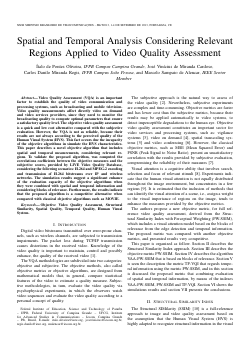
Spatial and Temporal Analysis Considering Relevant Regions Applied to Video Quality Assessment
Ítalo de Pontes Oliveira, Jose Vinícius de Miranda Cardoso, Carlos Danilo Miranda Regis, Marcelo Sampaio de Alencar
DOI: 10.14209/sbrt.2013.160
Evento: XXXI Simpósio Brasileiro de Telecomunicações (SBrT2013)
Keywords: Objective Video Quality Assesment Structural Similarity Spatial Quality Temporal Quality Human Visual System.
Abstract
Video Quality Assessment (VQA) is an important factor to establish the quality of video communication and processing systems, such as broadcasting and mobile television. Video quality measurements affect directly video on demand and video services providers, since they need to monitor the broadcasting quality to compute optimal parameters that ensure a satisfactory quality level. The objective video quality assessment is a quick and low cost alternative compared with the subjective evaluation. However, the VQA is not as reliable, because their results are not always according to the perceived quality of the Human Visual System (HVS). This fact occurs due the incapacity of the objective algorithms in simulate the HVS characteristics. This paper describes a novel objective algorithm that includes spatial and temporal measurements, considering relevant regions. To validate the proposed algorithm, was computed the correlations coefficients between the objective measures and the subjective scores, provided by LIVE Video Quality Database, considering the following scenarios: H.264 and MPEG-2 encoding and transmission of H.264 bitstreams over IP and wireless networks. The simulation results suggest a significant enhance of the evaluation capacity of the objective algorithms when they were combined with spatial and temporal information and considering blocks of relevance. Furthermore, the results indicate that the proposed algorithm is a competitive alternative when compared with classical objective algorithms such as MOVIE.Download